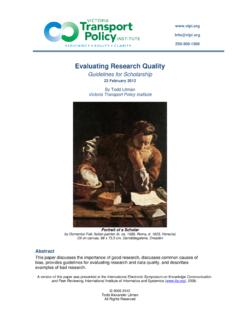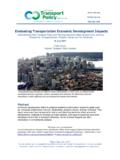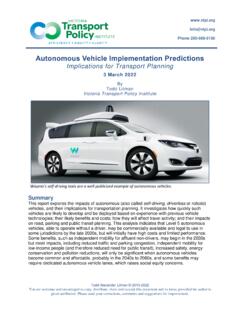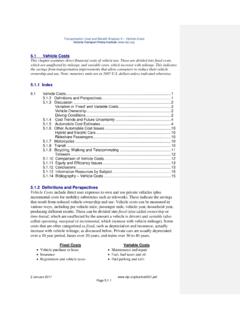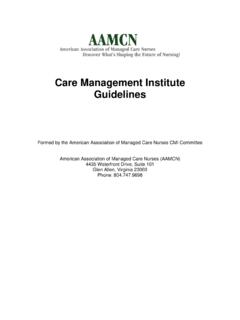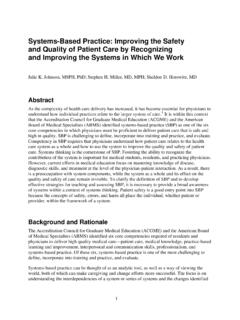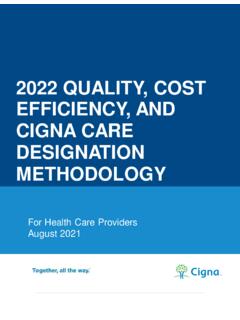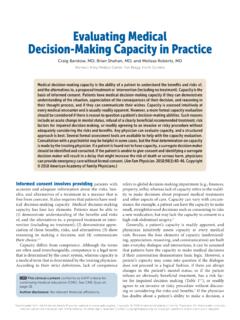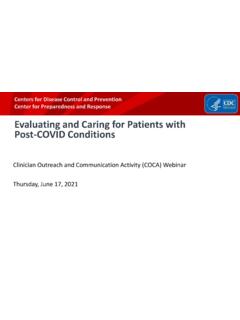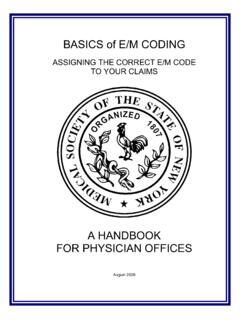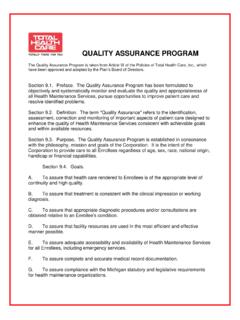Transcription of Evaluating Public Transit Benefits and Costs
1 250-508-5150 Todd Alexander Litman 1996-2021 You are welcome and encouraged to copy, distribute, share and excerpt this document and its ideas, provided the author is given attribution. Please send your corrections, comments and suggestions for improvement. Evaluating Public Transit Benefits and Costs Best Practices Guidebook 17 December 2021 Todd Litman Victoria transport Policy Institute Abstract This guidebook describes how to create a comprehensive framework for Evaluating the full impacts ( Benefits and Costs ) of a particular Transit service or improvement. It identifies various categories of impacts and how to measure them. It discusses best practices for Transit evaluation and identifies common errors that distort results. It discusses the travel impacts of various types of Transit system changes and incentives. It describes ways to optimize Transit Benefits by increasing system efficiency, increasing ridership and creating more Transit oriented land use patterns.
2 It compares automobile and Transit Costs , and the advantages and disadvantages of bus and rail Transit . It includes examples of Transit evaluation, and provides extensive references. Many of the techniques in this guide can be used to evaluate other modes, such as ridesharing, cycling and walking. Evaluating Public Transit Benefits and Costs Victoria transport Policy Institute 1 Contents Executive Summary .. 2 Introduction .. 4 Public Transit s Role in an Efficient and Equitable Transportation System .. 5 The Importance of Comprehensive Analysis .. 8 Evaluation Best Practices .. 9 Evaluating Transit Service Quality .. 11 Travel Impacts .. 13 Transit Demand .. 17 Transit Impact Categories .. 23 Transit Expenditures .. 23 Impacts on Existing Transit Users .. 24 Mobility Benefits .. 25 Efficiency Benefits .. 29 Travel Time Impacts .. 56 Land Use Impacts .. 59 Economic Development Impacts .. 62 Impact Summary.
3 67 Evaluating and Quantifying Transit Benefits .. 70 Comparing Transit and Automobile Costs .. 73 Perspectives .. 76 Common Errors Made When Comparing Transit and Automobile transport .. 79 Transit Versus Automobile Comparison Summary .. 80 Evaluating Transit Criticism .. 81 Is Transit Travel Slow and Inefficient? .. 83 Is It Cheaper To Subsidize Cars Instead Of Transit ? .. 85 Rail Versus Bus Transit .. 86 Advantages of Rail .. 86 Advantages of Bus .. 87 Summary of Rail Versus Bus .. 87 Strategies To Increase Transit Benefits .. 90 Transit Priority .. 90 Parking Management .. 90 Commute Trip Reduction Programs .. 90 Campus and School transport Management 91 Marketing and User Information .. 91 Nonmotorized Improvements .. 91 Transit Oriented Development .. 91 Least Cost Planning .. 91 Evaluation Examples .. 92 Conclusions .. 109 References And Resources For More Information .. 112 Evaluating Public Transit Benefits and Costs Victoria transport Policy Institute 2 Executive Summary Public Transit (also called Public transport or mass Transit ) includes various services that provide mobility to the general Public , including buses, trains, ferries, shared taxi, and their variations.
4 It can play important and unique roles in an efficient and equitable transport system by providing affordable basic mobility for non-drivers, efficient urban travel, and a catalyst for more efficient land use development. It can therefore have diverse impacts ( Benefits and Costs ), including many that are indirect and external (they affect people who do not currently use Transit ). Some result from the existence of the service, others from Transit use, some from reduced automobile travel, and others from Transit s ability to affect land use development patterns, as summarized in Table ES-1. Not all Transit services have all of these impacts, but most have several. Table ES-1 Public transport Benefits and Costs Improved Transit Service Increased Transit Travel Reduced Automobile Travel Transit -Oriented Development Metrics Service Quality (speed, reliability, comfort, safety, etc.) Transit Ridership (passenger-miles or mode share) Mode Shifts or Automobile Travel Reductions Portion of Development With TOD Design Features Potential Benefits Improved convenience and comfort for existing users.
5 Equity Benefits (since existing users tend to be disadvantaged). Option value (the value of having an option for possible future use). Improved operating efficiency (if service speed increases). Improved security (reduced crime risk) Mobility Benefits to new users. Increased fare revenue. Increased Public fitness and health (by stimulating more walking or cycling trips). Increased security as more non-criminals ride Transit and wait at stops and stations. Reduced traffic congestion. Road and parking facility cost savings. Consumer savings. Reduced chauffeuring burdens. Increased traffic safety. Energy conservation. Air and noise pollution reductions. Additional vehicle travel reductions ( leverage effects ). Improved accessibility, particularly for non-drivers. Community cohesion and reduced crime risk. More efficient development (reduced infrastructure Costs ). Farmland and habitat preservation.
6 Potential Costs Higher capital and operating Costs , and therefore subsidies. Land and road space. Traffic congestion and accident risk imposed by Transit vehicles. Transit vehicle crowding. Reduced automobile business activity. Various problems associated with more compact development. Public transport can have various types of Benefits and Costs , many of which tend to be overlooked or undervalued in conventional transportation economic evaluation. Conventional transport economic evaluation tends to overlook and undervalue many Transit Benefits . These evaluation practices originally developed to assess roadway improvements and focus primarily on vehicle travel speeds and operating Costs . They do not generally quantify or monetize the Benefits of basic mobility Benefits , vehicle ownership and parking cost savings, or efficient land development Benefits . Evaluating Public Transit Benefits and Costs Victoria transport Policy Institute 3 Public Transit can also have significant Costs , including facility Costs , operating Costs , and various external Costs such as accident risk and pollution imposed on non-users.
7 Many of these Costs are fixed so Transit services tend to experience scale economies (unit Costs decline with increased use), resulting in low marginal Costs . These factors should be considered when Evaluating Public Transit Benefits and Costs : Public Transit can provide various types of impacts. Comprehensive evaluation should consider all significant Benefits and Costs . Many Transit services (those that operate at times and places with low demand) exist mainly to provide basic mobility for non-drivers. Although relatively costly per trip, they are often cheaper than alternatives such as taxis and chauffeuring (drivers making special trip to carry non-drivers, which often requires empty return trip), or inadequate mobility for non-drivers. High quality (relatively fast, convenient, comfortable and integrated) Transit can attract discretionary travelers who would otherwise drive, which reduces traffic problems including congestion, parking Costs , accidents and pollution emissions.
8 Transit that attracts discretionary travelers provides consumer welfare (surplus) Benefits , since they would not change mode if they did not consider themselves better off overall. High quality Transit can stimulate Transit -oriented development, compact, multi-modal neighborhoods where residents tend to own fewer vehicles, drive less and rely more on alternative modes than in more automobile-oriented communities. This can leverage additional travel reductions and Benefits (besides just the travel shifted to Transit ). Traffic congestion tends to maintain equilibrium: it increases until delays discourage additional peak-period vehicle trips. High quality, grade-separated Transit can reduce traffic congestion Costs by reducing the point of equilibrium, offering travelers an alternative to driving, and by supporting compact development which reduces travel distances. Highway expansion tends to induce additional vehicle travel which increases external Costs such as downstream congestion, parking demand, traffic risk, barrier effects, and pollution emissions, Costs that are avoided if travelers instead shift to Public Transit .
9 These impacts should be considered when comparing roadway expansions with Transit improvements. Transit travel time unit Costs (dollars per hour or cents per minute) vary significantly depending on travel conditions and user preferences. Many travelers prefer high quality Transit even if it takes longer than driving because they can work or rest. These impacts and Benefits tend to increase if Transit improvements are implemented with support strategies such as walking and cycling improvements, more compact development, transportation demand management programs, and efficient road and parking pricing. Since active transport (walking and cycling) and Public Transit are complements, Transit travel tends to increase Public fitness and health. Public Transit services have three features that justify Public support and underpricing: they help achieve social equity objectives, they experience scale economies, and they can reduce various external Costs including traffic congestion, accident risk and pollution emissions.
10 Current demographic and economic trends (aging population, rising fuel prices, urbanization, changing consumer preferences, increasing health and environmental concerns) are increasing demand for Transit and Transit -oriented development, and therefore their Benefits . Evaluating Public Transit Benefits and Costs Victoria transport Policy Institute 4 Introduction Public Transit (also called Public transportation, Public transport , mass Transit and urban Transit ) includes various transport services available to the general Public including vanpools, buses, trains, ferries, and their variations. These services can play various roles in a modern transport system and provide various Benefits , including direct Benefits to users and indirect Benefits that result if Transit helps reduce automobile travel or create more compact. This guidebook describes how to evaluate the value to society of a particular Transit service or change in service.
